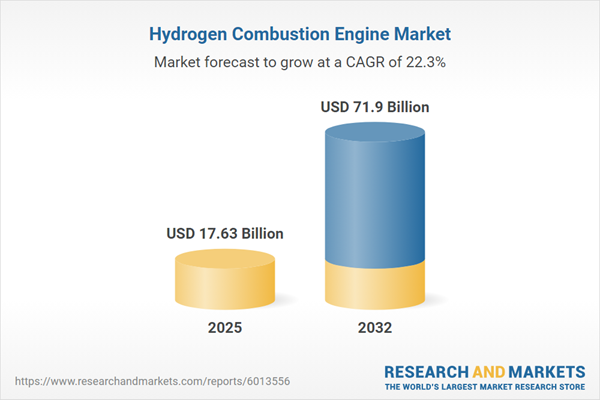Speak directly to the analyst to clarify any post sales queries you may have.
Hydrogen combustion engines are emerging as a viable pathway for organizations intent on achieving sustainability targets while maintaining operational reliability. Senior leaders are now evaluating where hydrogen solutions can fit within long-term decarbonization strategies and how these engines can help safeguard ongoing business performance.
Market Snapshot: Hydrogen Combustion Engine Market
The global hydrogen combustion engine market is entering a period of strong growth, powered by broadening adoption across transportation, industrial, and commercial sectors. In 2024, the market size is valued at USD 14.36 billion, with expectations to reach USD 17.63 billion by 2025—propelled by a compound annual growth rate of 22.3%. This uptick is underwritten by evolving policy mandates, sector-wide efficiency imperatives, and robust infrastructure investment. Established manufacturers are turning to hydrogen solutions both to foster innovation and to align with shifting regulatory standards. Supportive government frameworks, along with cross-industry technology transfer, are helping to scale up deployments and create a dynamic landscape for hydrogen engine adoption.
Scope & Segmentation
This comprehensive report is designed specifically for executives, outlining where hydrogen combustion engines can drive both operational gains and broader strategic value. The following segments and categories define the most relevant perspectives and potential market entry routes:
- Vehicle Type: Assesses potential for hydrogen integration in commercial vehicles, off-highway machinery, passenger cars, and two-wheelers. Each presents unique requirements for technical adaptation and compliance.
- End User Industry: Examines penetration across automotive manufacturing, heavy-duty equipment, marine transport, power generation, and railway operations. Sector-specific considerations address reliability and adherence to regulatory standards.
- Power Output Range: Outlines available engine types from compact options under 100 kW to midrange (101–1000 kW) and high-capacity models above 1000 kW, enabling alignment with a wide variety of real-world applications.
- Combustion Technology: Reviews technology variants such as direct and port injection, as well as naturally aspirated and turbocharged engine designs, each suited to particular operating environments and regulatory contexts.
- Fuel Blend: Offers analysis of pure hydrogen and hybrid dual-fuel approaches, which improve flexibility and compliance during phased energy transitions. Examples include hydrogen-diesel and hydrogen-natural gas mixtures.
- Geographic Coverage: Brings perspectives from the Americas, Europe, Middle East, Africa, and Asia-Pacific, with focused insight into strategic regions like China, India, Japan, and Australia to inform regional approaches for multinational firms.
- Key Market Players: Profiles leading industry participants including Cummins Inc., MAN Energy Solutions SE, Wärtsilä Corporation, Doosan Heavy Industries & Construction, Kawasaki Heavy Industries, Porsche AG, BMW AG, Toyota Motor Corporation, Iveco Group N.V., and Scania AB—supporting peer benchmarking and due diligence.
Key Takeaways
- Hydrogen combustion engines enable continuous operation where battery-electric solutions fall short due to infrastructure or demanding application needs, ensuring support through transitional supply chains and evolving market conditions.
- Technological innovations—such as more advanced injection mechanisms, ignition controls, and durable engine materials—are boosting durability and performance, meeting the reliability expectations of operational leaders.
- Industry collaboration between manufacturers, energy suppliers, and research organizations is accelerating time-to-market for hydrogen engine solutions, helping firms navigate commercialization challenges efficiently.
- Segment-level analysis empowers decision-makers to steer capital into the most promising regions and applications, aligning investments with compliance plans and performance objectives.
- Variability in infrastructure readiness and diverse regulatory requirements across global regions highlight the need for flexible, adaptive rollouts and market entry strategies tailored for complex multinational environments.
- Adopting multi-fuel architectures and flexible engine platforms allows enterprises to remain resilient amid policy shifts and evolving standards, reducing exposure to unforeseen compliance risks.
Tariff Impact
Recent changes in US tariffs on hydrogen combustion engine components are influencing sourcing strategies, with companies shifting toward local suppliers to increase operational resilience. This adjustment is driving deeper supplier partnerships and renewed focus on domestic workforce development, ensuring the technical skills necessary to support ongoing adoption. These efforts collectively help sustain industry growth despite evolving regulatory pressures.
Methodology & Data Sources
This executive report synthesizes insights from in-depth leadership interviews, independent technical analysis, and contributions from industry experts and leading academic institutions. Scenario analysis, technology maturity assessment, and end-to-end value chain mapping form the evidence base for actionable recommendations, supporting informed decisions in the hydrogen combustion engine sector.
Why This Report Matters
- Supports executive teams in identifying priority market opportunities through detailed segmentation and market analysis that aligns with strategic goals.
- Provides a structured resource to enhance compliance posture, optimize supply chain initiatives, and coordinate phased adoption of new hydrogen technologies.
- Delivers pragmatic guidance for risk management in the face of tariff changes and operational uncertainty, strengthening overall organizational agility.
Conclusion
Hydrogen combustion engines represent a pivotal element in decarbonization efforts, providing both sustainability benefits and robust operational performance. Targeted partnerships and upskilling initiatives equip organizations to adapt confidently to shifts in technology and regulation.
Additional Product Information:
- Purchase of this report includes 1 year online access with quarterly updates.
- This report can be updated on request. Please contact our Customer Experience team using the Ask a Question widget on our website.
Table of Contents
3. Executive Summary
4. Market Overview
7. Cumulative Impact of Artificial Intelligence 2025
Companies Mentioned
The companies profiled in this Hydrogen Combustion Engine market report include:- Cummins Inc.
- MAN Energy Solutions SE
- Wärtsilä Corporation
- Doosan Heavy Industries & Construction Co., Ltd.
- Kawasaki Heavy Industries, Ltd.
- Porsche AG
- BMW AG
- Toyota Motor Corporation
- Iveco Group N.V.
- Scania AB
Table Information
| Report Attribute | Details |
|---|---|
| No. of Pages | 182 |
| Published | November 2025 |
| Forecast Period | 2025 - 2032 |
| Estimated Market Value ( USD | $ 17.63 Billion |
| Forecasted Market Value ( USD | $ 71.9 Billion |
| Compound Annual Growth Rate | 22.3% |
| Regions Covered | Global |
| No. of Companies Mentioned | 11 |









